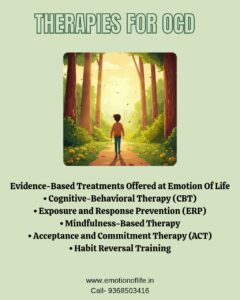
Obsessive-Compulsive Disorder (OCD) is a condition where individuals experience distressing thoughts (obsessions) and feel compelled to perform certain behaviors (compulsions) to reduce their anxiety. These patterns can become exhausting and impact everyday life—from relationships and career to emotional well-being.
However, OCD is treatable, and many people go on to lead balanced, healthy lives with the help of structured and effective therapies for OCD. At Emotion of Life, we specialize in providing personalized care, based on the unique experiences of each individual. Our therapeutic approaches are thoughtfully designed to reduce distress, build resilience, and restore a sense of control.
Why Focus on Therapies for OCD?
While OCD can feel overwhelming, it is highly responsive to the right therapeutic support. The goal of treatment is not to eliminate every intrusive thought but to change the relationship individuals have with these thoughts. Our approach helps individuals reduce their urge to act on compulsions, challenge obsessive thinking patterns, and gradually build confidence in managing uncertainty.
Let’s take a detailed look at the main therapies for OCD that we offer at Emotion of Life.
- Cognitive-Behavioral Therapy (CBT)
CBT is a structured form of talk therapy that helps individuals understand how their thoughts influence their emotions and behaviors. In OCD, distorted beliefs often drive compulsive actions—for example, the belief that “If I don’t check the gas stove five times, something terrible will happen.”
In CBT sessions at Emotion of Life, we:
– Identify the specific thought patterns causing distress
– Explore how those thoughts lead to compulsions or avoidance
– Work together to challenge and reframe those beliefs
– Teach practical strategies to respond differently in triggering situations
Over time, clients learn that their thoughts are not dangerous, and they don’t have to act on them. CBT helps in regaining trust in one’s own judgment and reducing the fear-based control OCD exerts.
- Exposure and Response Prevention (ERP)
When it comes to treating OCD, ERP is known to work really well. It involves two components:
– Exposure: Gradually and safely facing the thoughts, images, or situations that trigger anxiety.
– Response Prevention: Refraining from engaging in compulsive behaviors or rituals in response to anxiety.
At Emotion of Life, ERP is carefully structured and always collaborative. For example, a person who fears contamination might be guided to touch a doorknob and resist the urge to wash their hands immediately after. This is done gradually, starting with less distressing situations and building up to more difficult ones.
Through repeated practice, the anxiety associated with the trigger begins to fade. Clients discover they can tolerate uncertainty and discomfort without relying on rituals, which leads to greater independence and freedom from OCD’s grip.
- Mindfulness-Based Therapy
Mindfulness involves learning to observe thoughts and emotions without judgment. In OCD, people often respond to intrusive thoughts with fear, shame, or urgency. Mindfulness helps them pause and say, “This is just a thought—it doesn’t define me.”
In our therapies for OCD, mindfulness-based sessions teach:
– Non-reactivity: How to notice an obsessive thought without reacting
– Acceptance: Allowing discomfort to be present without trying to control it
– Grounding: Techniques to stay in the present moment and reduce overthinking
We also incorporate breathing exercises, visualization, and grounding tools that help clients stay calm and steady even during emotionally challenging moments.
- Acceptance and Commitment Therapy (ACT)
ACT is a powerful approach that blends mindfulness with value-driven action. Instead of trying to “get rid of” uncomfortable thoughts, ACT helps clients accept their mental experiences and take meaningful steps aligned with what they care about.
In sessions, clients explore:
– What truly matters to them (e.g., relationships, career, health)
– How OCD has been pulling them away from those values
– How to take small, courageous steps toward a meaningful life—even with anxiety present
ACT is especially helpful for people who feel stuck or demotivated. It helps them shift focus from fear-based decisions to value-based living.
- Habit Reversal and Compulsion Blocking Techniques
Many people with OCD engage in compulsions automatically. In our specialized therapies for OCD, we include techniques that help clients recognize their rituals and consciously interrupt or delay them.
This includes:
– Awareness training: Becoming more conscious of when compulsions happen
– Competing response strategies: Engaging in a different activity when the urge arises
– Delay and distraction methods: Learning to postpone the ritual, which often reduces its intensity
These tools build impulse control, confidence, and self-awareness over time.
How We Execute Therapies for OCD at Emotion of Life
Our process at Emotion of Life is detailed, structured, and always client-centered. Here’s how we walk alongside our clients on their journey:
Step 1: Initial Contact
We begin by understanding the individual’s concerns through an informal call or message. This first interaction is about listening openly and empathetically. No pressure, no judgment—just connection.
Step 2: Writing the Problem Statement
Before therapy begins, we help the client write their own “problem statement”—a simple, honest description of their distress. This might be, “I spend hours checking my locks and I feel exhausted” or “I get thoughts that scare me and I don’t know what to do.”
This serves as the emotional and psychological anchor of the therapy journey.
Step 3: In-Depth Assessment
Our assessment process includes:
– Clinical interviews
– Psychological questionnaires
– Pattern analysis of obsessions and compulsions
– Emotional impact and behavioral effects
This helps us understand the full scope of the issue—not just the symptoms, but the context behind them.
Step 4: Psychoeducation
We believe in empowering clients with knowledge. We explain what OCD is, how it functions, and what therapy can do. Clients often feel a sense of relief when they understand they’re not “going crazy”—they’re dealing with a condition that can be treated.
Step 5: Building a Personalized Therapy Plan
Using the insights from assessment, we build a therapy plan that may include CBT, ERP, ACT, mindfulness, or a combination. The plan is personalized to match:
– The client’s comfort level
– The type of OCD they’re experiencing
– Their life environment (school, work, family)
We involve the client in this planning process so they feel ownership of their journey.
Step 6: Execution of Therapy
Therapy is conducted through weekly or bi-weekly sessions with structured goals. For example:
– Week 1–2: Psychoeducation, identifying rituals, introducing CBT
– Week 3–5: ERP hierarchy building, response prevention, mindfulness practice
– Week 6–10: Continued exposures, deeper cognitive work, ACT strategies
– Week 11–14: Relapse planning, values exploration, long-term planning
Every step is monitored and adjusted as per the client’s progress.
Step 7: Long-Term Maintenance and Skill Building
We focus on long-term wellness. Even after therapy ends, clients are equipped with tools they can use lifelong. Booster sessions and check-ins are available to help them stay on track and catch any early signs of relapse.
We provide therapies for OCD for all major subtypes, including:
– Contamination OCD: Fears of germs or illness
– Checking OCD: Repetitive checking behaviors
– Relationship OCD (ROCD): Doubts in close relationships
– Harm OCD: It’s a form of OCD where a person constantly worries they might accidentally cause harm to others.
– Sexual Intrusive Thoughts: Disturbing but unwanted mental images or ideas
– Scrupulosity: Excessive concern about morality or religion
– Magical Thinking: Belief that unrelated actions can prevent bad things from happening
Each subtype requires a unique therapeutic plan, and that’s exactly what we offer at Emotion of Life.
Why Choose Emotion of Life for Therapies for OCD
Our team of experienced psychologists and behavior therapists work together to create a safe, non-judgmental, and supportive environment. We don’t rush the process, nor do we take a one-size-fits-all approach.
When you choose Emotion of Life, you choose:
– Compassionate professionals
– Customized therapy plans
– Step-by-step support
– Empowerment through knowledge
– Recovery that respects your pace and personality
Above all, you’re choosing a place where you’re seen not as a label—but as a whole person.
Living with OCD is not easy, but it’s absolutely possible to live a meaningful, fulfilling life beyond it. Through well-structured, scientifically informed, and empathetically delivered therapies for OCD, individuals can break free from the cycle of fear and compulsion.
At Emotion of Life, we are committed to walking with you from confusion to clarity, from anxiety to calm, and from fear to freedom.
You can write to us: info@emotionoflife.in or reach out us via call 9368503416 or visit our website- www.emotionoflife.in
